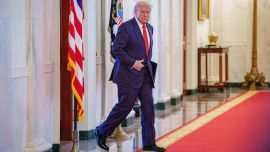Apart from confounding the opinion polls, last Sunday’s PASO primaries in Santa Fe also defied the grieta logic of a zero sum game whereby one side or other of the chasm has to win – last weekend both extremes lost. The Peronist administration of outgoing Governor Omar Perotti fell well short of 30 percent (fully 15 points down on its winning vote in 2019) but the opposition hawks also came a cropper – Maximiliano Pullaro, a Radical ex-minister from a previous socialist provincial administration, is the clear frontrunner to be Santa Fe’s next governor come September 10 after sweeping well over half of a Juntos por el Cambio mainstream opposition vote not far off two-thirds of the total.
More on the province below but the upset also has huge implications for the national campaign. Aided by the reprieve of a midyear dip in inflation, Economy Minister Sergio Massa had been fancying his presidential chances at the head of a united Peronism against a fragmented opposition, especially if he could make it into the runoff against a rival with a rightist image (Patricia Bullrich or libertarian Javier Milei) against whom to polarise the middle ground. But last Sunday’s meltdown was a cold bath of reality for Massa (can even Buenos Aires Province Governor Axel Kicillof now feel safe?) – not only a total of under 28 percent for the four Peronist hopefuls but his running-mate’s man finishing last of the four despite Cabinet Chief Agustín Rossi being a native of the province while allies of Massa’s primary rival Juan Grabois won in Rosario. Not that Peronist losses were Kirchnerite gains with just 4.1 percent for La Cámpora deputy Marcos Cleri.
The more extreme, the bigger the loss, it would seem, but ditto for the opposition. For several weeks now Milei’s opinion poll momentum has been undermined by provincial underachievement and the same could now be happening for Patricia Bullrich. The notion that gutsy aggression is the best sell electorally in times of crisis (which has yet to arrive, nevertheless) has been boosted by more than one opinion poll showing her 15, even 30 points ahead of her moderate rival for the Juntos nomination, outgoing City Mayor Horacio Rodríguez Larreta. Senator Carolina Losada, Bullrich’s Santa Fe gubernatorial hopeful, represented a steep escalation of that logic by insinuating (never actually stating) that Pullaro was in cahoots with Rosario’s murderous drug-traffickers via his coexistence with a corrupt provincial police when Santa Fe security minister, adding that she could not work with him on “ethical grounds.” The steeper the escalation, the harder the fall – Losada lost by a double-digit margin (21.5 percent against 32.5 percent for Pullaro) when the opinion polls had been forecasting a dead heat.
Bullrich should thus start having second thoughts about being guided by continuously fallible opinion polls where an intense minority gives her huge leads by coming forward as respondents while a silent majority drifts in a different direction but her candidacy’s problems could extend to the entire centre-right PRO party she chaired until taking campaign leave this year. Not only has that party made a modest contribution to the opposition gains inland (of the six defeats of incumbent governments in the last three months, four have come at the hands of Radicals and two from ex-members of the rebuffed régime) but its grip on its heartland in this city has been shaken. Pullaro was not only backed by Rodríguez Larreta but by Radical mayoral hopeful Senator Martín Lousteau, thus boosting the momentum from the successful demolition job on City Legislature candidate Jorge Rinaldi and the nagging questions about PRO’s Jorge Macri meeting the residential requirements to run.
Turning to Santa Fe, firstly the nuts and bolts of the PASO primary numbers. Only five of the 13 gubernatorial hopefuls cleared the 1.5 percent hurdle for running in September to succeed Perotti – frontrunner Pullaro, of course, Peronist Senator Marcelo Lewandowski (just under 18 percent), Edelvino Bodoira of Viva la Libertad with three percent for his pro-life stance, the Trotskyist Partido Obrero’s Carla Deiana with a winning share of the Frente de Izquierda y de Trabajadores-Unidad’s 2.7 percent and Eduardo Maradona with 1.95 percent for Elisa Carrió’s Coalición Cívica-ARI (a partner of the Juntos por el Cambio coalition with PRO and the Radicals nationwide but running outside its Unidos para Cambiar Santa Fe provincial branch where the Socialists replaced them as the third leg in the “front of fronts”).
Apart from Losada (second overall as well as within Unidos para Cambiar), the eight also-rans were headed by that third leg, Socialist Rosario ex-mayor Mónica Fein with nine percent. Three more were Peronists running way behind Lewandowski – deputies Cleri (4.1 percent) and Eduardo Toniolli of the Movimiento Evita picket movement (3.1 percent) with Rossi’s representative Leandro Busatto trailing (2.8 percent). The losing leftist Octavio Crivaro (1.2 percent), Gustavo Marconato (linked to former Economy minister Alfonso Prat Gay with 0.9 percent) and Moderado hopeful Walter Eiguren (0.4 percent) complete the field.
Losada at least had the consolation prize of her people winning Santa Fe’s three biggest cities (Rosario, the homonymous provincial capital and Rafaela) although this in some ways only underlines the failure of her aggressive approach since she herself ran well behind them. Rosario Mayor Pablo Javkin (of Coalición Cívica origins) looks set for re-election, frustrating a strong internal challenge from Pullaro’s man Miguel Tessandori (a football journalist like Lewandowski) but the big surprise was youthful leftist Juan Monteverde topping Perotti’s nominee Roberto Sukerman by a double-digit margin to wrest the Peronist mayoral candidacy, a huge boost for the Grabois challenge to Massa’s presidential candidacy. There was another surprise in the provincial capital where incumbent mayor Emilio Jatón was ousted within Unidos para Cambiar Santa Fe voting by hospital director Juan Pablo Poletti while the Peronist vote did not even reach double digits.
But beyond the cities Pullaro made a clean sweep of the 19 Santa Fe departments except Rosario where the highest single vote went to Lewandowski, not Losada, whose sophisticated urban image lost out badly to Pullaro’s tireless grunt work in the rural hinterland – perhaps as much a factor in her downfall as her aggressive tactics misfiring.
Many pundits read the turnout of 64 percent as a symptom of voter disenchantment but it was only a primary and comparable to the last elections. Where turnout was undeniably poor was in Rosario where only 226,365 citizens voted out of a population of 1,342,619 according to the 2022 census with fear of drug gang slaughter and Peronist disillusionment keeping many at home – perhaps a major factor in both the size of the Peronist collapse and Pullaro’s impressive margin.
In conclusion, there is no linear relationship between provincial and national voting nor between primaries and the real thing with arbitrary factors often decisive – one cynical government observer attributed the opposition victory to their having the livelier catfight and thus attracting more voters – but the importance of the country’s third-largest electoral district (almost eight percent of the national electorate or 2,818,280 voters) cannot be underestimated.
Tomorrow’s mayoral elections in the provincial capital of Córdoba (even more populous than Rosario with 1,565,112 inhabitants, according to the 2022 census, of whom 1,131,148 can vote) are almost as important but space is lacking for more than naming the two most important of the 11 mayoral candidates (who will receive a mention in next week’s column if justified by their votes) – Radical Rodrigo de Loredo for Juntos por el Cambio (one of the few opposition politicians admired by ex-president Mauricio Macri and Lousteau alike) and current Peronist Deputy Mayor Daniel Passerini, a physician – yet given the dismal performance of the opinion polls (not least for Santa Fe’s PASO primary) it is probably just as well to dispense with any forecast and await the actual results.




















Comments